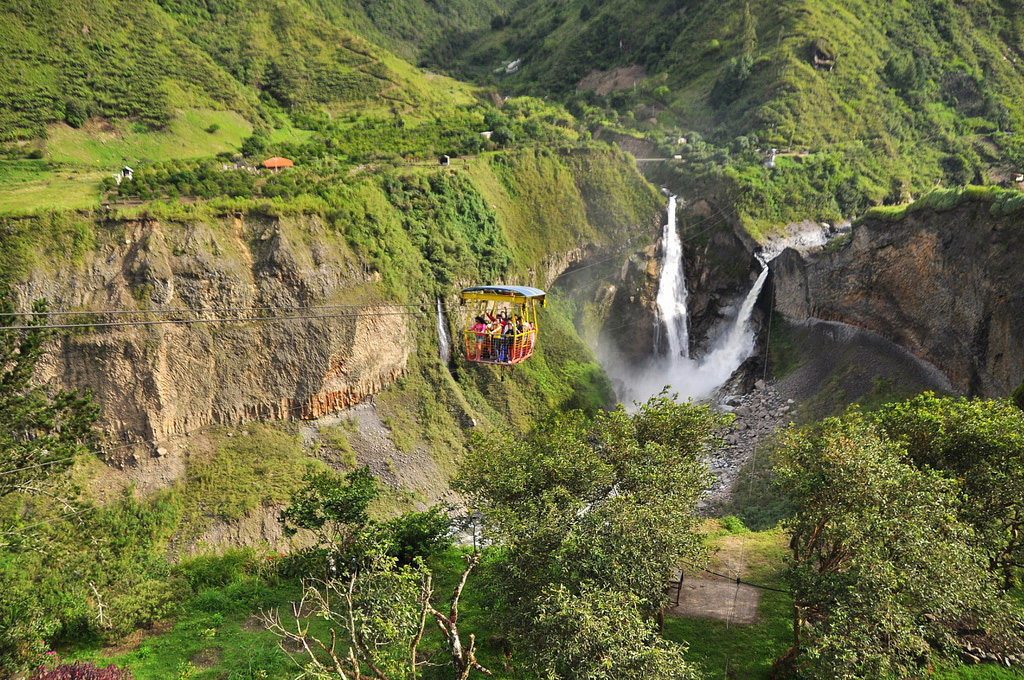
Tarabitas (cable-cars) cross the valley. Photo © Rinaldo Wurglitsch, licensed Creative Commons Attribution.
This spectacular 61-kilometer road drops nearly 1,000 meters in elevation along the Pastaza Valley to the edge of the Oriente. There are nearly a dozen waterfalls along the newly christened Ruta de las Cascadas, which has developed into a major tourist attraction with several tarabitas (cable-cars) across the valley as well as a range of adventure sports.There are three ways to see this route: You can hop on a Baños–Puyo bus and stop off at the waterfalls, take a guided tour, or the best option is to hire a bicycle and take in the scenery at your leisure and see how far you get toward Puyo. If you feel too tired to cycle back uphill, you can always take a bus back and stow your bike on top.
The new Baños–Puyo road goes through half a dozen tunnels, only the first of which is open to cyclists. Along the rest of the route cyclists bypass the tunnels and take the old road, enjoying wonderful canyon views along the cliff face.
Leaving Baños, cross the Agoyán hydroelectric dam and the first set of cable car rides to small waterfalls, including the Agoyán.
After 40 minutes, you pass one of the most impressive waterfalls on the route, Manto de la Novia (Bride’s Veil). For a small tip, the tarabita staff will watch your bike. Take the hair-raising tarabita ($1) 500 meters across the gorge from where you can take a short walk down to a viewing platform or a longer hike (20 minutes) down to the bottom of the gorge to stand at the foot of the waterfall. It’s an awe-inspiring sight, but also sobering. In February 2010 a huge landslide here killed five residents and swept away houses, and there are now two waterfalls where for centuries there was only one. You can cross the rickety bridge back across the gorge and walk back up to the main road.
After Manto de Novia, it’s 40 minutes farther to Río Verde, 18 kilometers from Baños, an emerging town with several hotels, small restaurants, and shops selling local crafts. More importantly, this is the access point to El Pailón del Diablo (Devil’s Cauldron), a dramatic waterfall tumbling between vertical walls into a deep depression. Follow the signs to the path leading down into a forested gorge, which offers welcome shade. There is a tiny suspension bridge (maximum capacity: 5 people), and it costs $1 to walk down to a set of three platforms to view the waterfall up close. There is also a path cut into the rocks called Grieta al Cielo (Crevice to Heaven) that you can walk along, crouching, to go inside a cave behind the waterfall.
Most people visit Río Verde for an hour or so, but the stunning setting has led to some good accommodations options. Miramelindo (Vía Baños–Puyo Km. 18, tel. 3/249-3004, $25 pp, breakfast included) has rustic guest rooms beside the river, with an orchid garden, a jetted tub, a sauna, steam baths, and free guided tours to the waterfall. A couple of kilometers farther east on the Baños–Puyo road is Pequeño Paraíso (tel. 9/981-9776, $17–20 pp, breakfast and dinner included), where comfortable cabins and dorms sit on grounds full of fruit trees with great views over the canyon.
About 2.5 kilometers east of Río Verde is the village of Machay, where trails lead up into the hills to a series of small waterfalls. The most impressive, Manantial del Dorado, is at the end of the trail, but this is quite a hike—over four hours there and back—and better done on a guided tour.
Most people turn back at this point, but if you keep going along the road, you’ll reach Río Negro, after which the scenery opens out to reveal views of the widening valley, and the scenery becomes noticeably more tropical. The town of Mera is next, after 17 kilometers, and then there’s a police checkpoint where you will probably be required to show your passport. About seven kilometers farther is the small airport of Shell, which runs small charter services to visit remote indigenous communities in the rainforest. About 10 kilometers farther on is Puyo.
Excerpted from the Fifth Edition of Moon Ecuador & the Galápagos Islands.